#Edwin is just Henry’s mysterious friend
Explore tagged Tumblr posts
Text

Michael doesn’t even know who FNAF Edwin is
#myart#chloesimagination#comic#fnaf#five nights at freddy's#fnaf fanart#edwin murray#michael afton#fnaf vanessa#fnaf vanny#security breach#secret of the mimic#fnaf pizzeria simulator#trash and the gang#like does Michael even know who Edwin is???#besides the dude who made Mr hugs vacuum???#he may also know his kid was hit by a car#or maybe not even he might of been too itty bitty to even know that#Edwin is just Henry’s mysterious friend#till further notice Edwin legally looks like this btw#he’s just a silhouette#the fucking mimic said so
4K notes
·
View notes
Text
I'm gonna ramble about researching books prepare thyself
Great Expectations
I got this old-looking copy of Great Expectations by Charles Dickens that was part of a larger collection of Dickens' works at a used bookstore on Tuesday. One of my favorite activities is trying to figure out when older books were published/printed, and I finally got around to it today.
A couple pages in there was a note that read "this edition contains all the copyright emendations made in the text as revised by the author in 1867 and 1868", and when I looked up the publishing company (The Colonial Press Incorporated) and "great expectations" or just "charles dickens" most online listings selling the entire collection claimed it's from 1868. The collection wasn't a staggered release, 18 out of the 20 books in the collection, which were published from 1837 to 1865, had that same "this edition contains all the copyright emendations made in the text as revised by the author in 1867 and 1868", so they were all published together.
The problem with stating the collection was from 1868 was because it so clearly wasn't. There were two books that didn't have the note about the 1867 and 1868 revisions: The Mystery of Edwin Drood and The Life of Charles Dickens by Everett H. Rupert. Edwin Drood was published in 1870, and its note read "'The Mystery of Edwin Drood' was first published as a volume in 1870 having previously been issued in month shilling parts from April to September of that year. The present Edition contains the fragment, 'How Mr. Sapsea ceased to be a member of the Eight Club,' discovered by Forster amongst the papers of Dickens after his death." (Charles Dickens died in June of 1870). Obviously a book can't be published before it's written, but hypothetically, if the collection had been published directly after Edwin Drood had been published, a two year difference isn't too bad. But the collection wasn't published in 1870.
The Life of Charles Dickens by Everett H. Rupert was published 1936. In this collection, instead of having a note about its contents, it just says "Copyright 1936". And, if you look into Colonial Press Inc., the only records of a Collection of Charles Dickens' works (of which the company published 2, different covers but same contents) were printed in 1936.
2. Oliver Twist and the Uncommercial Traveller
A couple months ago I got a copy of Oliver Twist and The Uncommercial Traveller at a used bookstore and also tried to figure out the year it was published today. Oliver Twist was published 1839 and the Uncommercial Traveller was published in 1861. On the first page, it listed the other Dickens' books included in the collection the book was a part of, and Our Mutual Friend, published in 1865, was also listed. Based off the appearance of the book, it was probably published before the 1940s, giving us an estimated publication range of 1865-1939.
At the bottom of the title page, it read:
"London
Chapman & Hall, Limited; And Henry Frowde
New York: Oxford University Press American Branch
91 & 93 Fifth Avenue"
I couldn't find any record of it ever being published by Chapman & Hall, but The Brethren Archive had a biography on Henry Frowde. Frowde was the manager of the London office of the Oxford University Press from 1874 to 1880, when he was promoted to Publisher to the University. He retired in 1913. At the bottom of the back of the title page, it says:
"Printed by Horace Hart
University Press, Oxford"
Hart worked as a printer for the Oxford University press from 1883 to 1915.
While that narrowed it down significantly to a date range of 1883 to 1913, there was one last thing that got me down to 2 different years :"91 & 93 Fifth Avenue" on the title page. 91 & 93 Fifth Avenue is a building in Manhattan in New York state in the U.S., that the Oxford University Press occupied in 1900 and 1905. I couldn't find anything else to narrow it down further to one of the years, but I found an online listing that dated it from 1900. Another interesting thing about this specific copy of this book, is every single photo I found of it online had a different printing location written: "35 West 32nd Street". All of these copies had the exact same cover and inside, except for that one detail. The copy I found listed from 1900 didn't have a photo of the title page, so it's very possible it wasn't the same copy, but that was as close as I was able to get it.
3. The Old Curiosity Shop
There was one book I still haven't been able to find online. It's a copy of The Old Curiosity Shop by Charles Dickens, published by Thomas Y. Crowell & Company Publishers. Crowell & Co. published three separate collections of Charles Dickens' works, but I couldn't find any record of this copy ever existing. The closest thing I found was a book that had the same interior, the same title page, the same illustrations, and so on, but it had a completely different cover. I'm not sure if it was simply never recorded or the original owner had gotten the copy of the book I have rebound, but according to the internet this copy of The Old Curiosity Shop doesn't exist.
#anyways i love doing this so much if anyone has any old books send me photos I'll try and figure out when it was published#ITS SO FUN#charles dickens#great expectations#oliver twist#the uncommercial traveller#the old curiosity shop#two-bit talks
2 notes
·
View notes
Text
Pancake’s Pride Month Book Recs!
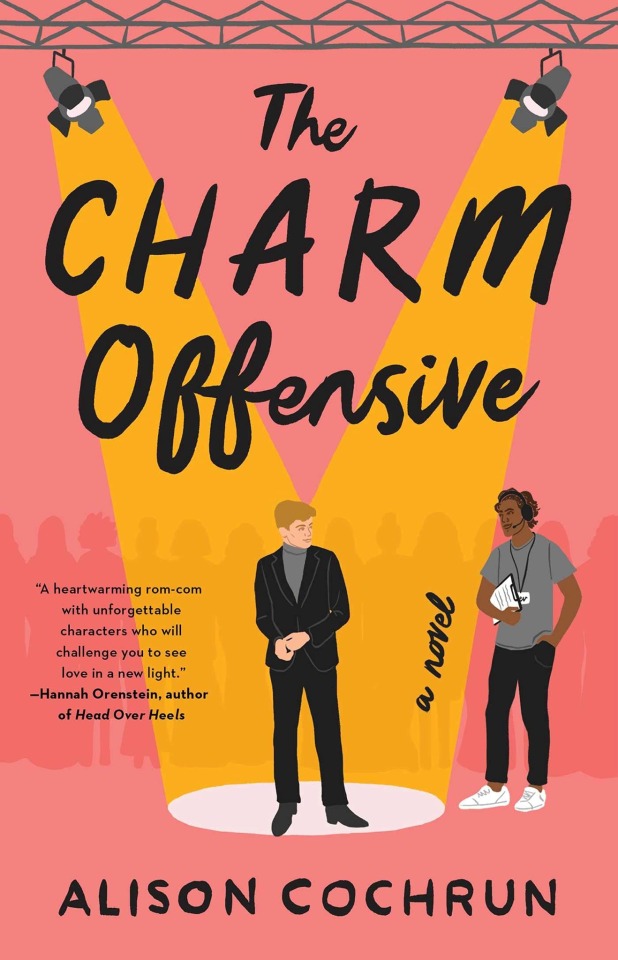
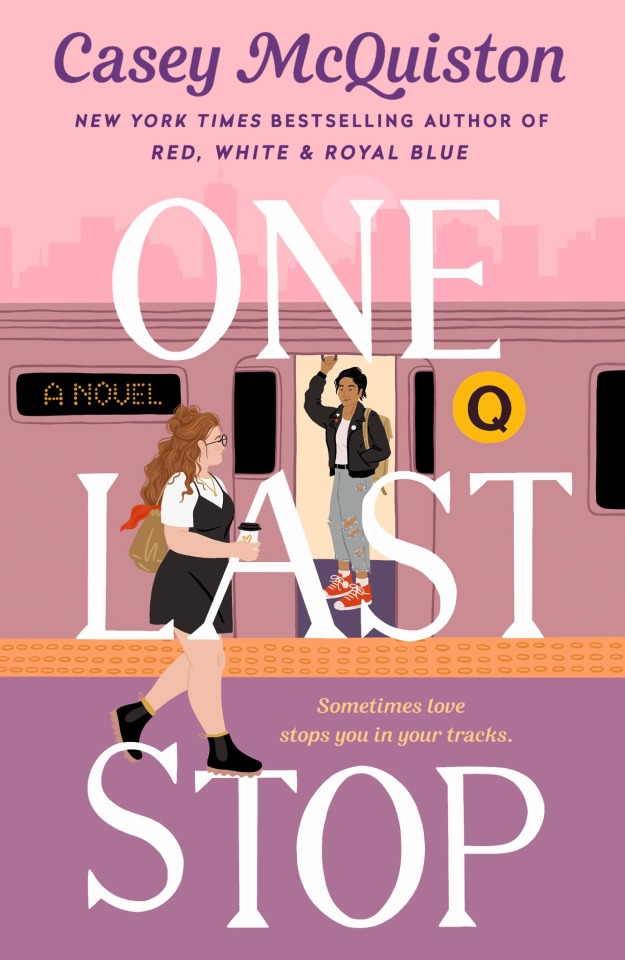

The Delightful Romance Novels
These three books are heavy on the romance and read like the best fanfiction, with plenty of humor and heartbreak before the (spoiler alert) happy ending!
The Charm Offensive by Alison Cochrun:
Dev works as a producer on a Bachelor-like reality TV show and desperately wants his own happily ever after. Enter Charlie: this season’s Prince Charming, who’s anxious and afraid to let anyone in, but handsome as hell. Secret dating and strong mental health themes round it all out to make this mlm + aspec romance a wonderful read 😊
One Last Stop by Casey McQuiston:
23yo August falls in love on the New York Subway when she sees the leather-jacket-clad Jane who’s quite literally stepped out of the 70s and into the modern day. Between the lovable queer community, drag queens, pancakes, and time travel mystery, this wlw book is so so great!
A Marvellous Light by Freya Marske
After landing a government job he knows nothing about, Robin finds himself embroiled in a magical side of London he also knew nothing about. In Edwardian England, he teams up with the incredibly smart but reserved magician Edwin to figure out what happened to his missing predecessor. There are libraries and labyrinths and countryside manors, spicy scenes and an inventive magic system in this mlm romance ✨ plus, a wlw sequel is coming out later this year 👀
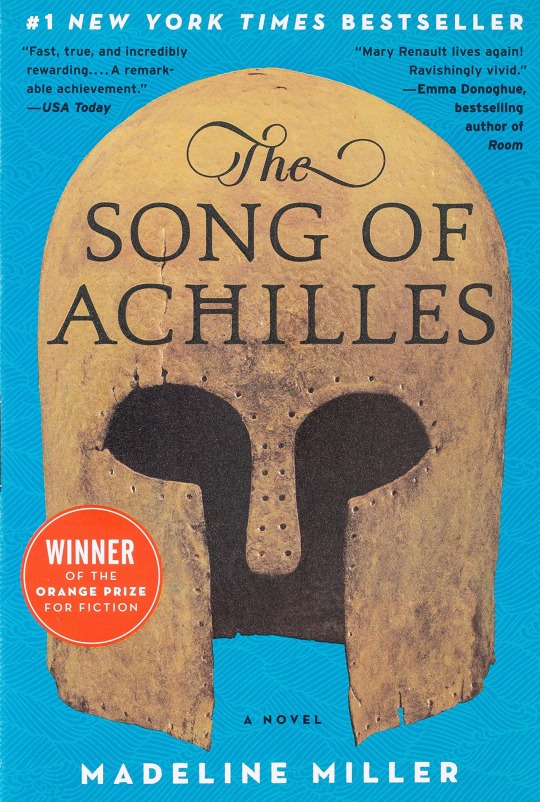

The Sad Gays
Don’t expect a happy ending with these, but they’re gorgeous love stories that will stick in your mind and refuse to leave.
Song of Achilles by Madeline Miller
A retelling of the Illiad through Patroclus’s POV, as he and Achilles fall in love as young boys and become fiercely devoted to each other. But of course there’s war and glory and tragedy to be had… this one’s heart wrenching for sure! But oh it’s a beautiful read 💜
The Seven Husbands of Evelyn Hugo by Taylor Jenkins Reid
In a fictionalized old Hollywood, the beautiful young Evelyn Hugo does whatever it takes to become a star and goes through seven marriages in the process. Although that’s what she’s famous for, the book is actually about hiding queerness when coming out could have wrecked your career— I got wayyy more emotionally compromised from this book than I expected! (There’s wlw and mlm in it!)


The Magical Bisexuals
The Chosen and the Beautiful by Nghi Vo
This one’s a retelling of The Great Gatsby, but from the POV of Daisy’s friend Jordan Baker. In this version, Jordan is a Vietnamese queer woman with a talent for magical paper craft. In fact, just about every character is now queer! It’s not a simple love story, but it’s certainly one to suck you into it’s hazy world of parties and poor choices. There’s one scene in particular that has stuck with me for months now.
The Invisible Life of Addie LaRue by V.E. Schwab
As a hopelessly lost 20-something this one really hit home for me— we quickly learn that the immortal Addie LaRue is forgotten by everyone she meets until she comes across Henry who somehow remembers her. The book alternates telling her 300 year history (beginning in France when she gets her curse) and their present day story. Both main characters are bi! This is one book I absolutely didn’t want to end.


The Fantasy Trilogies
The Shades of Magic Trilogy by V. E. Schwab:
This trilogy is mostly about the magic plot of parallel universe Londons and the struggles of its main characters, with a side of romance. While I’m p sure all the characters are bi, there is definitely a take-my-breath-away mlm romance. And oh! The characters! They’re wonderful— from the powerful but leashed magician Kell to the girl with all the knives Lilah to the charming but hurting prince Rhy. They simply don’t let go of your heart even after you’re done reading.
The Simon Snow Trilogy by Rainbow Rowell:
The mlm romance takes center stage in this trilogy!! They’re rivals at their magic school which is delicious in itself, but add to that an interesting breakdown of the chosen one trope, an amazing dive into how depression can affect your relationship, vampiric self-discovery, and downright hilarious writing and I can’t tell you how many times I’ve listened to these audiobooks 😅
I think a lot of people have probably already read many of these books but eh, whatever— they’re my fave queer books I’ve read in the last few years! 💖💜💙
12 notes
·
View notes
Text
My Pictures for Schools - Hertfordshire
In Hertfordshire the County Council’s collection of pictures for schools was started in 1949 as part of the School Loan Collection, a post-war initiative by Sir John Newsom, the Hertfordshire Chief Education Officer at the time. The aims of Pictures for Schools were to provide education for children, show children contemporary art rather than reproductions of masters and to liven up classrooms that in post-war Britain would have needed modernisation.
Many of the pieces were purchased from reputable dealers, artists and the ‘Pictures for Schools’ exhibitions which took place from the 1950s and 1960s. I thought I would show some of the pictures I now own and put the biographies of the artists.
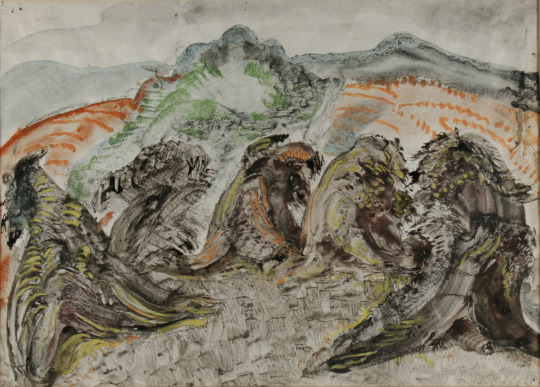
Vera Cunningham - 'Stooks',
Born in Hertfordshire of Scottish parentage, Vera studied painting at the Central School of Arts and Crafts. She began exhibiting with the London Group in 1922. With Matthew Smith, she exhibited in Paris at the Amis de Montparnasse and the Salon des Indépendants in 1922. Her first one-man show was held at the Bloomsbury Gallery in 1929. She produced a number of theatre designs at the end of the 1930s, but returned to easel painting. During WWII she was involved in the Civil Defence Artists' shows at the Cooling Galleries. After the war her Paris dealer, Raymond Creuze, mounted three exhibitions in 1948, 1951 and 1954. She lived in London. The Barbican Art Gallery held a retrospective exhibition in 1985. Her work is held in the Manchester City Art Gallery; the Guildhall Gallery, London and at Palant House, Chichester.
Cuningham modeled for and had relationships with fellow artists Bernard Meninsky and Matthew Smith.

Vera Cunningham - 'Garden Scene',
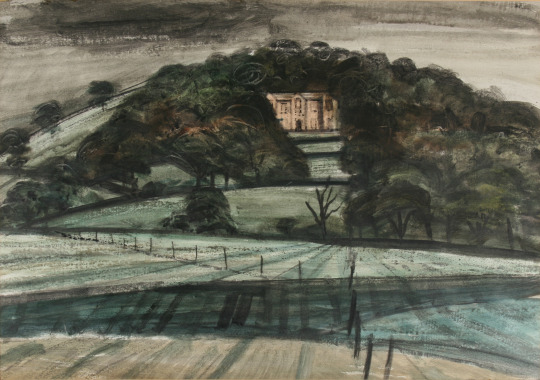
Thomas William Ward - 'Charmouth Manor'
Thomas William Ward, was born at Sheffield. Studied part-time with Eric Jones (Harold Jones's twin brother) at Sheffield 1937-1939. After service during the Second World War, Bill continued his studies at the Royal College of Art 1946-1950, winning a silver medal in 1949. He married at Kensington, London in 1949, sculptor Joan Palmer Ward. He taught at Harrow College of High Education 1950-1980, finally as principal lecturer, retiring to Suffolk in 1980. Elected a member of the Royal Society of Painter Etchers in 1953 and the Royal Society of Painters in Watercolour in 1957. This painting was bought from Whitworth Art Gallery, Manchester in 1957.

Alistair Grant - 'The Weight-lifter'
Although best known as a printmaker, Alistair Grant also painted throughout his career and in the 1980s he adopted an expressionist style using vibrant colours. He was born in London and studied at Birmingham College of Art (1941-43). After serving during the war, Grant returned to art school and the Royal College of Art, where he was taught by Carel Weight and Ruskin Spear. Grant was to work in the printmaking department of the Royal College for 35 years (1955-90), ending his career as Emeritus Professor of Printmaking at the RA.
The Weight-lifter was bought from the Whitechapel Art Gallery at their Pictures for Schools exhibition: 8 October – 29 October 1949. It is likely ‘Eva’s House’ came from a similar exhibition.
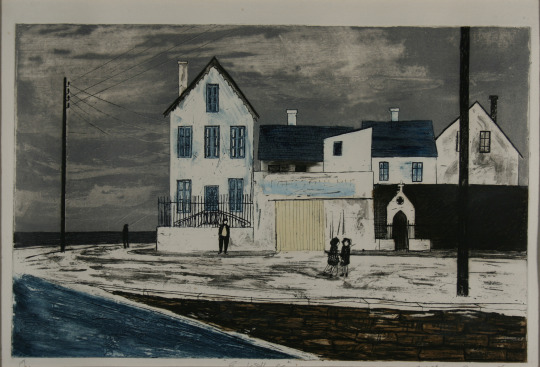
Alistair Grant - 'Eva's House', 1955

Vincent Lines - 'Old Hereford Wagon',
Vincent Lines was awarded a scholarship to the Royal College of Art in 1928. The principal, William Rothenstein described him as ‘one of the best students of the painting school’. While only in his twenties, he was appointed principal of Horsham School of Art and later became principal of Hasting School of Art. Lines was a prolific and talented topographical watercolourist, with an intimate knowledge of the countryside, which he recorded on the spot, in the open air.
He was chosen as an artist for the Recording Britain project, to which he contributed twenty watercolours. He was a close friend of Thomas Hennell and the pair often painted together in the countryside around Hennell’s home at Ridley, near Meopham in Kent.
Lines survived the war and went on to become Vice-president of the Royal Watercolour Society. He wrote the biography of Mark Fisher and Margaret Fisher Prout, illustrated Rex Waites ‘The English Windmill’
The war years brought deepened friendships in particular with Mildred Eldidge and Thomas Hennell, both fellow watercolourists of the R .W .S . Through contact with Hennell he became fascinated by country crafts and together they hunted out the potter and the cooper, wheelwright and blacksmith, hurdlemaker and charcoal burner.
During 1943-4 he painted a series of eight watercolours recording the avenues of elms in Windsor Park, before the trees were felled. The pictures are now in the Royal collection. A further commission for Vincent during these years was the contribution to Arnold Palmer’s four-volumed Recording Britain, published in association with the Pilgrim Trust.
Due to Thomas Hennell’s death in 1945 the illustration of Rex Wailes’s book The English Windmill, which would certainly have been done by him, passed instead to Vincent Lines. Wailes’s definitive survey presents English windmills in their history, construction and mode of working. Resurgence Magazine Issue 141, Jul 1990.

Molly Field - 'Farm Implements'
Molly Field was born in Keighley, Yorkshire. She originally worked under the name Molly Clapham but then married the artist Dick Field. Attended Leeds College of Art (1932-33) then the Royal College of Art (1934-38), with Ernest Tristram. Showed at the Royal Academy, Women’s International Art Club and the Wakefield. Also known under Mary Field.
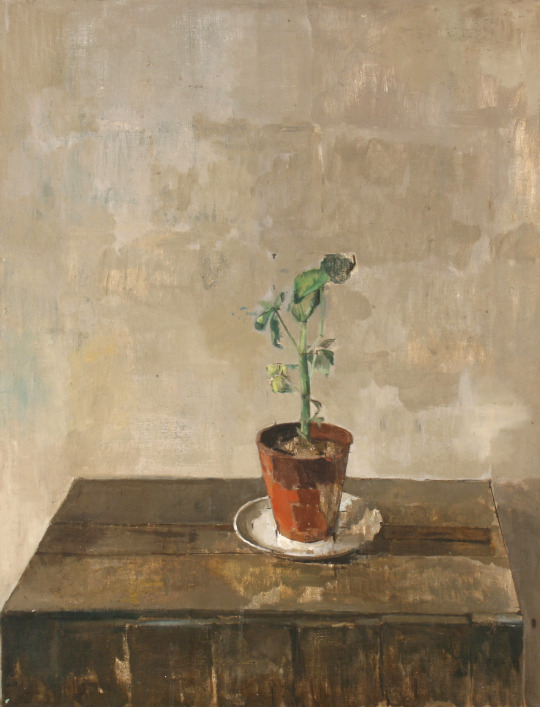
M Murphy - 'Geranium'
This is a mystery as it is one of the best paintings in the collection but there is no detail in the archives about who it is by.

Berard Gay - 'Ivy Plant'
Bernard left school at the age of 14 and after various jobs, just before the Second World War joined the merchant navy. In 1947 that he returned to education, studying textile part-time at the Willesden School of Art (1947-52) and changed course to fine-art under Maurice de Sausmarez and Eric Taylor. He began drawing classes at St Martins School of Art and quickly established himself as a painter. It may have been in the Pictures for Schools exhibition 23 January – 14 February 1954.

David Koster - 'Cat and Lilies'
Koster studied at the Slade School of Art (1944-47). Taught drawing and print-making at Medway College of Design. One-man shows at Everyman Foyer Gallery (1958, 60, 62, 64, 66, 68, 70); Glasgow Citizen's Theatre (1965); Stable Theatre Gallery, Hastings (1967). Taken several illustration commissions including work for the RSPB and a front cover for their 'Birds' Magazine.
David Koster was born in London and attended the Slade School of Fine Art from 1944 to 1947. He was a founder Member of the Society of Wildlife Artists in 1964.

Raymond Croxon - 'View in the Lake District',
Raymond Coxon enrolled at the Leeds School of Art, and the Royal College of Art. While he was there, between 1919 and 1921, he not only met his future wife but also became friends with a fellow student, Henry Moore. In 1922 Moore and Coxon visited France and met a number of artists there, including Pierre Bonnard and Aristide Maillol. Coxon continued his studies in London at the Royal College of Art between 1921 and 1925 under Sir William Rothenstein. Coxon took a teaching post at the Richmond School of Art in 1925 and in 1926 he married Edna Ginesi, with Moore acting as his best-man. Coxon would later perform the same service for Moore when he married Irina Radetsky in July 1929. He became a member of the London Group in 1931 and of the Chiswick Group in 1938.
During the WW2 he became a war artist and was commissioned to produce some paintings of Army subjects in Britain. Then working for the Royal Navy as a war artist. The painting of this print is in the collection of Palant House. The lithograph made for the Contemporary Lithographs Ltd. Other artists in the series were Eric Ravilious, John Piper, Vanessa Bell, Barnett Freedman and so on.
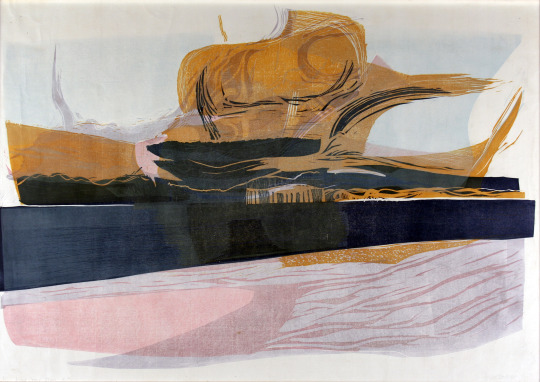
Julia Ball - 'East Coast Storm'
Julia Ball is a Cambridge artist and this woodcut came up for sale with the Cambridge collection of Pictures for Schools but due to a cataloguing error on the auctioneers I didn’t win it as they had labeled it as a different lot. For years I smoldered about that. But when the Hertfordshire sale came up, I had to have it. Made in the 1960s this woodcut is of a storm over the east coast. Her painting are mostly abstract and works can be found in Kettles Yard and in the New Hall art collection. This picture was bought from the Royal Academy Diploma Galleries, 1967.
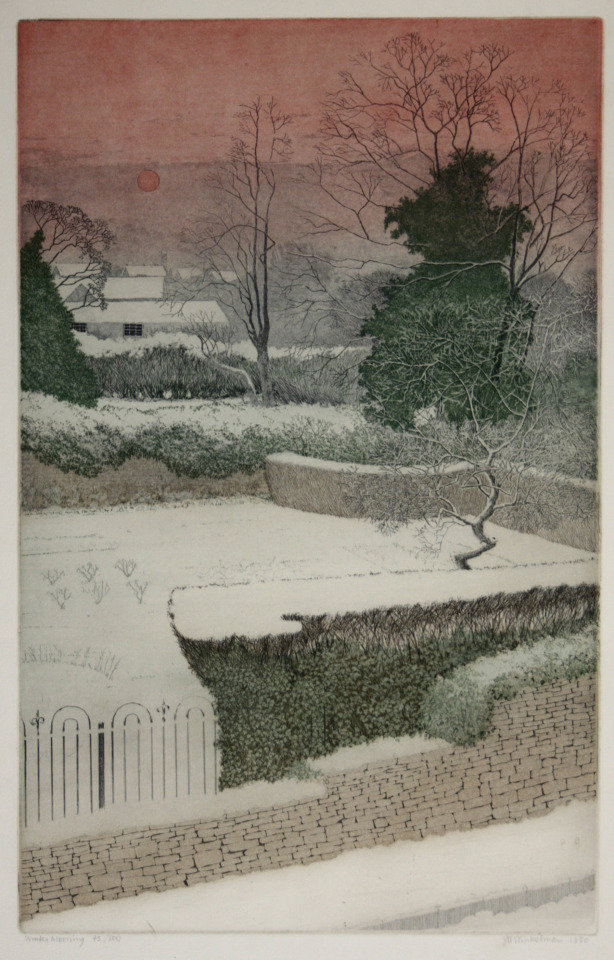
Joseph Winkelman - 'Winter Morning'
Joseph Winkelman has specialised in intaglio printmaking since 1975 after completing the Oxford University Certificate course in Fine Art at the Ruskin School of Drawing. As an active member of the Royal Society of Painter-Printmakers (RE), he served as President from 1989 to 1995 and was recently artist in residence at St John's College, Oxford.

John Sturgess - 'Black and White Leaf'
A student at the Royal College of Art in the 1950s. He would have been taught by Julian Trevelyan, Edwin La Dell, Edward Ardizzone and Edward Bawden. He worked with John Brunsdon as a printer, printing other artists work, rather than going into teaching. They set up a press in Digswell Art Centre and that is likely how his work ended up in the Hertfordshire Collection. This work of a leaf looks more like foil, it is rather beautiful and a lithograph on stone. Though I haven’t photographed it the frame is a John Jones frame made of aluminium and is as beautiful as the print.
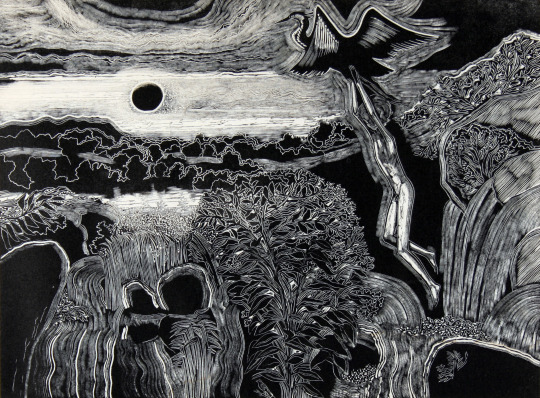
John O'Conner - 'Boy and the Heron'
John O'Connor A.R.C.A. R.W.S, is today best known for his woodcuts, but during his lifetime he was also celebrated as a watercolourist. In 1930 he enrolled at Leicester College of Art before moving on to the Royal College of Art in 1933. His teachers at this time were Eric Ravilious, John Nash and Robert Austin. He graduated in 1937.
On a visit to Eric Ravilious’s home at Bank House, Castle Hedingham in Essex, O'Connor was captivated both by the directness of the wood-engraving technique, and by the simple domestic scene in which Ravilious engraved by a lamp in one corner of the room while his wife Tirzah played with their small son by the fire in another. It was due to Ravilious that O'Connor got his first commission of work aged 23, illustrating Here’s Flowers by Joan Rutter for the Golden Cockerel Press in 1937.
He taught at Birmingham and Bristol before serving in the Royal Air Force form 41-45. On being demobbed he illustrated two books for the Golden Cockerel Press and taught in Hastings for two years before moving to Colchester to become the head of the School of Art in 1948. He was affectionately known as ‘Joc’ to his students, using his initials. His colleagues included Richard Chopping, who designed dust jackets for the James Bond novels, his own former teacher John Nash, and Edward Bawden, one of the finest British printmakers.
He saw his favourite painting places in Suffolk - the ponds, willows, briars and honeysuckle - disappear beneath the bulldozer and combine harvester. In 1964 O'Connor retired from teaching full time at Colchester, to concentrate on painting and engraving. He wrote various 'How to’ books and taught part time at St Martin’s School of Art. In 1975 he and his wife, Jeannie, went to live by Loch Ken in Kirkcudbrightshire, where his love of light and water inspired his many watercolours and oil paintings. He took up a post teaching at Glasgow School of Art from 1977 to 1984.
In the 1950s and 60s, O'Connor exhibited at the Zwemmer Gallery, in London, and had many exhibitions throughout Britain. His work was purchased by the Arts Council, the Tate Gallery, the British Museum and the Contemporary Art Society, as well as by several local education authorities; it can also be found in the Oslo Museum, the Zurich Museum and at New York central library. He was elected to the Royal Society of Painter-Etchers and Engravers in 1947, and, in 1974, to the Royal Watercolour Society. He was an honorary member of the Society of Wood Engravers.
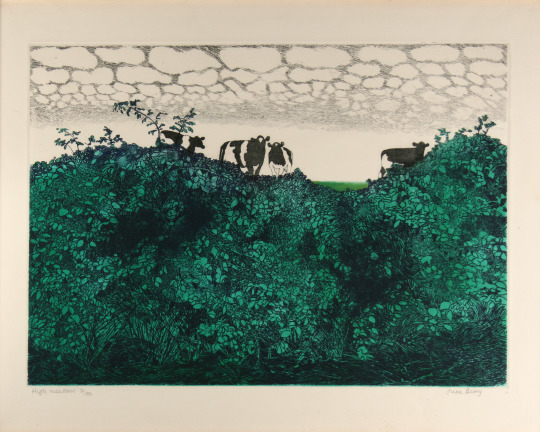
June Berry - 'High Meadow'
June Berry studied painting at the Slade School of Fine Art, London. She has had nineteen solo exhibitions including a retrospective at the Bankside Gallery, London in 2002. Her paintings have been exhibited frequently at the Royal Academy Summer Exhibition, London since 1952. Berry was Vice-President of the Royal Watercolour Society from 2001 to 2004.
Her work is included in the collections of HM the Queen, the British Government Art Collection, the Victoria & Albert Museum, London, the National Museum of Wales, the Royal West of England Permanent Collection, the Graphothek, Berlin, Germany and the All Union Society of Bibliophiles, Moscow, Russia. Her work has also been purchased by many private collectors in the UK, USA, Germany and Russia. She is a Member of the Royal Watercolour Society, the Royal Society of Painter-Printmakers, the New English Art Club and is a Royal West of England Academician.

Madeleine Holtom - 'Orchids'
Madeleine Elizabeth Anderson was born in Belvedere, Kent. She studied art at the Kingston School of Art where Reginald Brill was principal with other teaching from Anthony Betts, William Ware and John Platt. In 1932 she was awarded a scholarship to study at the Royal College of Art, there she won the painting prize in 1934. She painted in oils and watercolours under William Rothenstein and Gilbert Spencer.
Leaving the RCA she became a professional artist and also worked making advertisements. She married and divorced G. H. Holtom and they had two sons and two daughters, they moved to Northwood near Watford, North-West London. She also exhibited with the New English Art Club.
Her work is represented in the collections of: Friendship House, Moscow. Queen’s College, Oxford. The Cuming Museum. Cheltenham’s Art Gallery. The Government Art Collection, British High Commission, Accra, Ghana.

Frank Freeman - 'Flower Piece',
Frank Freeman is a bit of a mystery to me at the moment. I can find mention of him in a few places but sadly due to the blitz and poor archiving many are the lost. What is known is he was supported for a while by Lucy Carrington Wertheim and he was based in the Manchester area. One flower painting is mentioned in her book Adventure in Art.
Visitors who came to see me about this time. Among these were Frances Hodgkins, who stayed for months at a time at my flat, Henry Moore and his lovely Russian wife, John Skeaping, Barbara Hepworth, Cedric Morris, Lett Haines, John Alford, William Plomer, Leon Underwood, John Gould Fletcher, Pavel Tchelitchew, Komisarieysy, David Fincham and his wife Sybil, Jim Ede and Frank Freeman. Lucy Carrington Wertheim - Adventure in Art, 1947 p10-11

John Wynne-Morgan - 'Christmas Roses'
John Wynne-Morgan was born in Harrogate, Yorkshire and enrolled at the Heatherley School of Fine Art in London in 1945.
In a 1962 London catalogue foreword, Wynne-Morgan is described as ‘primarily a portrait painter’ (though the show contained scenes of Paris, Ibiza, Venice and London, and he also painted many Bonnard-ish nudes). His studio was in Hampstead and he was the author of three books for aspiring artists. In Oil Painting as a Pastime: A Complete Course for Beginners (Souvenir Press, London, 1959), he evokes how hard it is to embark on a portrait:

Edna Rodney - 'Parrot Tulips'
Of all the artists I bought Edna Rodney eludes me, I can not find her anywhere and it might be she was an art student who gave up art for a family or she might have been one of Hertfordshire’s pupils that ended up in the collection as sometimes happened. It is rare to find nothing however.
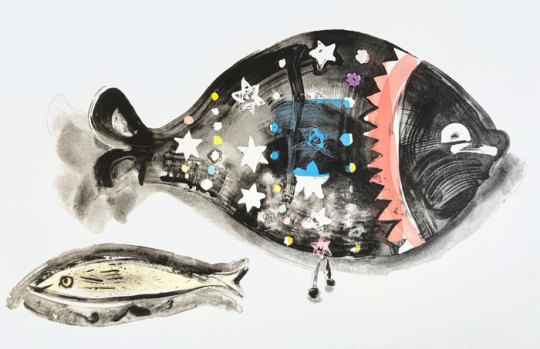
Chloë Cheese - 'Lucky Fish',
Chloëʼs childhood was spent in the Essex village of Great Bardfield observing the printmaking of her mother Sheila Robinson and she remembers in particular often visiting the studios of fellow printmakers Edward Bawden and Michael Rothenstein.
She has contributed to a recent book Bawden, Ravilious and the Artists of Great Bardfield published by the V&A. Chloë studied at Cambridge Art School from 1969 and the RCA from 1973 to 1976.
She has lived in South London since the 70s, investigating her home and surroundings first through drawing which is then used as a basis for the creation of monoprints, lithographs and etchings. Her engagement with still life subjects has widened to include figures against the palimpsest of an urban life.
Chloë has exhibited widely and her work is held in various public collections including The V and A Museum London and The Arts Council of Great Britain. Bio via St Judes.
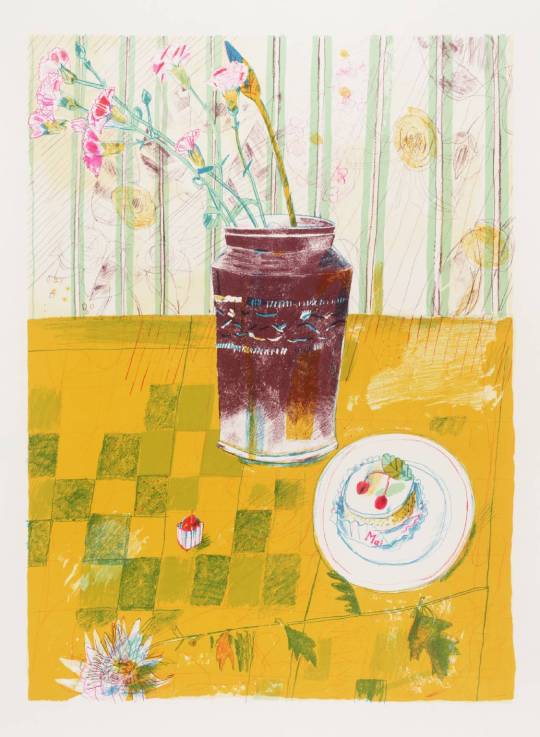
Chloë Cheese - 'Pink Carnations',
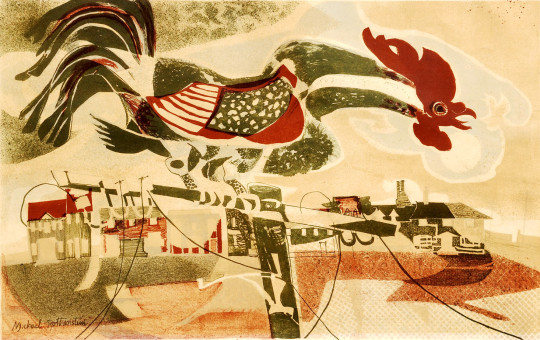
Michael Rothenstein - 'Coronation Cockerel'
Born in Hampstead, London, on 19 March 1908, he was the youngest of four children born to the celebrated artist, Sir William Rothenstein and his wife Alice Knewstub. He studied at Chelsea Polytechnic and later at the Central School of Arts and Crafts. Affected by lingering depression, Rothenstein did little art making during the late 1920s and early 1930s. Despite this, he had his first one-man show at the Warren Gallery, London in 1931.
During the late 1930s the artist's output was mainly Neo-Romantic landscapes and in 1940, like Vincent Lines, he was commissioned to paint topographical watercolours of endangered sites for the Recording Britain project organised by the Pilgrim Trust. In the early 1940s he moved to Ethel House, in the north Essex village of Great Bardfield.
At Great Bardfield there was a small resident art community that included John Aldridge, Edward Bawden and Kenneth Rowntree. In the early 1950s several more artists (including George Chapman, Stanley Clifford-Smith, Audrey Cruddas and Marianne Straub) moved to the village making it one of the most artistically creative spots in Britain. Rothenstein took an important role in organising the Great Bardfield Artists exhibitions during the 1950s. Thanks to his contacts in the art world (his older brother, Sir John Rothenstein, was the current head of the Tate Gallery) these exhibitions became nationally known and attracted thousands of visitors.
From the mid-1950s Rothenstein almost abandoned painting in preference to printmaking which included linocut as well as etchings. Like his fellow Bardfield artists his work was figurative but became near abstract in the 1960s.
Although little known as a painter, Rothenstein became one of the most experimental printmakers in Britain during the 1950s and '60s.
Rothenstein was elected an Associate of the Royal Academy (ARA) in 1977 and a Royal Academician (RA) in 1984. Near the end of his life there was a retrospective of his work at the Stoke-on-Trent City Museum and Art Gallery (1989) and important shows followed at the Fry Art Gallery, Essex.
The print I have (The Cockerel) was made for the Festival of Britain series of prints in 1951 and is signed under the mount. Likely bought from Redfern Galleries.

My blog of some of my pictures from the Cambridgeshire Collection of Pictures from Schools is here.
For areas of research I am indebted to Catherine Davis and Natalie Bradbury.
#Michael Rothenstein#Chloe Cheese#Pictures for Schools#Vera Cunningham#Alistair Grant#Vincent Lines#Molly Field#Berard Gay#David Koster#Raymond Croxon#Julia Ball#John O'Conner#Madeleine Holtom#Frank Freeman#John Wynne-Morgan
2 notes
·
View notes
Text
An Art History Primer
by Kristian Krawford
I spent many years studying art history in school and dearly loved it. So allow me a few moments to share the fruits of my education with you. Here is your art schooling without the cost of tuition. And you can really impress your friends with all your refinement!
We begin in Egypt from 3,000 to 330 BC. The style was marked by stiff figures in profile, subject matter was gods and goddesses, kings and queens, jackal-headed deities and the occasional cat. Egyptians were strong believers in the afterlife and decorated tombs with things they felt one needed in eternity.
Greece from 1200-200 BC. Not much art has survived from this period other than pots, all decorated in geometric patterns—zigzags, chevrons, checkerboards, diamonds. Also Homeric scenes and later some Kouroi statues.
Rome from 700 BC- AD 500. Virtually everything we know of Greek art comes to us from the Romans. They were the ultimate copycats, conquering the Greek world and plundering their treasures. They did the same to Egypt. They were the first art patrons and art collectors. A tradition that continued for centuries.
The Dark Ages AD 600-1350. This title is a misnomer as it was a very exciting time in the world. This was the era of beautiful churches, of Charlemagne (my own great-grandfather), the university and of some really beautiful art.
Charlemagne was King of the Franks and the first Holy Roman Emperor. His empire was called Carolingian and he set out to change the world. He built monasteries and churches, basilicas, murals, sculptures and frescoes—almost none of which have survived. What have survived are beautiful illuminated manuscripts from this time period, which is also called Romanesque because it draws on Roman models.
One way it was Roman-like was in its bigger and better churches. The architecture at the time, centered in Paris, was called Gothic by Giorgio Vasari, who intended it as an insult. It means “crude and barbaric.” Gothic style was simply the over decoration of a house of God. Elaborate stone tracery, crested finials, painted details—miscellaneous doodads. All crafted by anonymous artisans.
A French historian (Jules Michelet) coined the term Renaissance, meaning “rebirth,” in the 1800’s. And because the subject is so broad and involves so many artists, I could go on for pages. So for the sake of brevity, some things will receive only a passing mention.
The Renaissance can be divided into High and Low or Early and Late. The major artists of the Early Period were Giotto (first to paint three-dimensional people); Masaccio (mastered groups of figures); Lorenzo Ghiberti (spent 21 years working on the bronze doors of the Florence Baptistery aka. Gates of Paradise); Donatello (invented relief sculpture); and Filippo Brunelleschi (architect of the Duomo and first to apply the rules of perspective to art).
The major artists of the Late Period were: Sandro Botticelli (known for sensuous human forms, i.e. Birth of Venus); Leonardo da Vinci (arguably the most famous artist ever of the most famous painting ever, i.e. Mona Lisa); Michelangelo (started out in Florence, moved to Rome to paint the Sistine ceiling); Raphael (another darling of the papacy and one of my personal faves. I love School of Athens); Tintoretto (he closes out the High Renaissance with a Mannerist style); and Titian (greatest Venetian painter, he painted a lot of mythological subjects).
Some interest tidbits about Leonardo before closing out the Renaissance entirely. Leonardo wasn’t just an artist. He was a scientist, architect, engineer, draftsman, inventor and jack of all trades. He studied the human body by dissecting cadavers and imagined flight hundreds of years before the Wright brothers. He was interested in everything, yet finished almost nothing. He was a master of unfinished work. In fact, the Mona Lisa is one of only a handful of pieces he ever completed. And it was his personal favorite that he carried with him until his death. For centuries, Mona Lisa has remained an enigma. Not just her identity but her unusual expression. Is she or isn’t she smiling? According to Vasari, Leonardo painted a very melancholy sitter. He employed magicians, jesters and theatre performers to entertain her while he painted. It was while painting this portrait that he developed his sfumato technique (Italian for “like smoke”) in which colors and form subtly merge. It would become his trademark.
The Northern Renaissance is also divided into Low and High. These are the best known Low artists: Jan van Eyck (founder of Flemish painting, he painted the Ghent Altarpiece); Rogier van der Weyden (known for attention to detail and portraits of nobles); and Hieronymous Bosch (known for fantastical landscapes of a dark, medieval world).
The High Artists of the Northern Renaissance are: Albrecht Durer (not to my liking but this German artist is known for his engravings and woodcuts); and Pieter Breughel the Elder (Flemish painter known for allegories and parables of peasant life).
Baroque came after the Renaissance. It was a time of courtly festivals and royal ceremony. The term meant to be an insult—“degenerate.” Caravaggio was the most famous Baroque artist. A rogue character (even tried for murder), he was a naturalistic painter known for dramatic light. He placed ordinary people in his paintings of religious subjects. Scandalous! Peter Paul Rubens painted nobles while El Greco was known for his elongated figures. Rembrandt, considered the greatest Dutch painter ever, was known for his unusual lighting in which he made the most ordinary of people look mysterious. Jan Vermeer, also known for interesting light effects, enjoyed painting the Dutch bourgeoisie. Lastly, Velazquez was a great Spanish painter most interested in royalty.
From the 1700’s to the 19th century, there were four major art movements: Rococo, Neoclassicism, Romanticism, and Realism.
Rococo (c. 1730-1800) was art of the boudoir. It was a flirty, fanciful way of decorating the canvas. The main artists (all French) were Francois Boucher, Jacques-Louis David (I can’t stand that guy), Jean-Auguste Dominique Ingres, Eugène Delacroix and Gustave Courbet.
Neoclassicism (c. 1750-1820) was a genre in which artists copies the simple designs and restrained ornament of the ancient Greeks and Romans. The main artists Jacques-Louis David (I still can’t stand him), Antonio Canova, Jean-Antoine Houdon (known for his amazing bust sculptures of Ben Franklin and George Washington) and Jean-Dominique Ingres.
Romanticism (c. 1780-1850) was melodramatic portrayals of imaginary subjects. The best known artists were Eugène Delacroix, Francisco de Goya and William Blake—a wonderful writer who illustrated his poems.
Realism (c. 1848-1875) was basically a reaction to the excesses of Romanticism and some Neoclassicism. In this movement, it was the Americans who led the way. Many were painting beautiful landscapes of their young nation on large canvases. The landscapists were Thomas Cole, Frederic Edwin Church, Albert Bierstadt and Thomas Moran. Realist artists were Winslow Homer and Thomas Eakins.
Ah, Impressionism! Who doesn’t love it? It all began in 1874 when a group of Paris-based artists who’d been rejected by the Salon were mockingly called “Impressionists” by the April 25th issue of Le Charivari magazine. The name stuck. The style itself was marked by a close observation of nature whereby marks of pure color are placed side by side to create the effects of light on the canvas. They also differed in subject matter, tossing out literary subjects, mythology, and even history. They focused instead on scenes of everyday life. They also abandoned contour, modeling and precise details.
Though Èdouard Manet is the founding father of Impressionism, it is Claude Monet who is most often associated with it. Other stars are: Edgar Degas (he favored ballet dancers); Auguste Renoir (young women and rosy-cheeked girls); Alfred Sisley (the only Brit in the mix); and Mary Cassatt (the only American and most famous woman).
From 1874 to 1886, the Impressionists exhibited together a total of 8 times, but long before they broke up, the members were moving on to other things.
Post-Impressionism is a catch-all term to describe all the art that came after Impressionism. It also relied on the use of bright colors and splashy brushwork, but differed in what artists were feeling and saying. The stars of this movement were: Georges Seurat (inventor of Pointillism and a personal fave); Paul Gaugin (the native-loving man of bright colors); Vincent Van Gogh (most mad and magnetizing); and Henri de Toulouse-Lautrec (decorative posters of cabaret life).
Expressionism was marked by sometimes violent colors, abstract forms and emotional subjects. The big Expressionists were: Edvard Munch; Henri Matisse (inventor of Fauvism); Wassily Kandinsky (inventor of Abstraction); and Amadeo Modigliani (lover of long, lean bodies and necks); and the Viennese love-chronicler, Gustav Klimt.
Cubism is my least favorite genre so will receive scant mention here. It was the first totally abstract art movement—not at all representational—relying on geometric forms. Created by Pablo Picasso and Georges Braque, they were influenced by Cézanne, modern science and African masks.
Dada was a brief European anti-art movement that sprang up after WW1. It spawned the likes of Marcel Duchamp, Max Ernst and Man Ray. I take back what I said about Cubism being my least favorite. Dada is.
Surrealism came after Dada and although it was primarily a literary movement, it translated well into art. Basically about the relationship between dreams and the unconscious, this movement gave us Marc Chagall, Joan Miró and Salvador Dalí.
Constructivism was another brief art genre, this one centered in Russia. It spawned no internationally known starts, only regional artists on a mission.
Abstract Expressionism was about bigness—big canvases, big brushes, big cans of house paint, big male egos. It was also almost totally American. The main men were: Jackson Pollock (big drips and splatters); Willem de Kooning (brushy abstractions); and Mark Rothko (large blocks of color).
Pop Art is populist art. It’s representational and easily comprehensible. It’s spawned some very famous artists—Jasper Johns, Robert Rauschenberg, Andy Warhol and Roy Lichtenstein, to name a few. These artists rejected nature and instead focused on the manmade.
Minimalism came after Pop Art and spawned Frank Stella and a few minor artists.
So what genre is the art of today and where is it headed? Well, all the art since is generally lumped into the category of post-modernism and involves artists deriving their work from both natural and manmade sources. Today artists even use a third source—the wonderfully human imagination. Artists also create their work from many different mediums. Today, we have oil painters, acrylic artists, watercolorists, charcoal and pencil artists, collage artists and even mixed-media artists who use a combination of all of the above to create their unique works. And let’s not forget digital artists who create their imaginary worlds entirely on computer. Though future historians will have a difficult time categorizing the art of today, one thing is for certain: they won’t lack for interesting and beautiful paradigms to study.
#art history#artessay#artists#artprimer#arteducation#essays#essay#fyi#so you know#valuableinformation#goodstuff#artthroughtheages#history
4 notes
·
View notes
Text
15 famous and inspiring photographers
Walker Evans influenced Robert Frank. Eugène Atget inspired Berenice Abbott. Alfred Stieglitz mentored Paul Strand. Invented in the 19th century, photography is a relatively young medium, but its brief history has been shaped—at least in part—-by the relationships that form between artists and generations. Up-and-coming photographers stand on the shoulders of their predecessors; they borrow their ideas, and they reinvent them.
For emerging and established artists alike, revisiting the work of renowned photographers can provide motivation and foster fresh innovations. In this article, we revisit ten of history’s most important and talked-about photographers, and we also take a look at five outstanding photographers who are part of the 500px community today. Read on for your daily dose of inspiration.
Sally Mann (1951-present)
Though she was already an acclaimed photographer at the time, Mann became a household name in the early 1990s, when she released Immediate Family, a collection of photographs of life with her three children in the rural landscape of the Virginia hills.
Featuring childhood adventures, nosebleeds, and wet beds, the book and exhibition revealed a hidden side of family life, rarely depicted in art. She’s returned to the book throughout the years, providing timely insights into the changing and shifting nature of American childhood in this day and age.
She has also revisited her own family—including her husband Larry—as model, muse, and inspiration, and her home in the Southern United States has served as both a backdrop and a main character in her more recent photographs.
Although her subject matter might have evolved, Mann’s raw and compassionate approach to family, memory, and the inevitable passage of time has become an ever-present theme.
Browse her photographs here.
Learn more about Sally Mann: Listen to her NPR interview, “Making Art Out Of Bodies: Sally Mann Reflects On Life And Photography”.
Henri Cartier-Bresson (1908-2004)
A co-founder of Magnum Photos and pioneer of street photography, Cartier-Bresson preferred never to use flash and used 35mm film in lieu of large or medium formats. His legacy revolves around what he called “the decisive moment.” Cartier-Bresson reasoned that if a photographer could witness the moment he wished to capture, it was already too late to photograph it. Instead, Cartier-Bresson focused on learning to read social cues and hone his intuition in order to capture moments as they happened.
Browse his photographs here.
Learn more about Henri Cartier-Bresson: Read this scan from the MoMA library, complete with text and images.
Gordon Parks (1912-2006)
As Life magazine’s first African American staff photographer, Parks documented some of the most important moments in the American Civil Rights Movement. He had access to the movement’s leaders, including Martin Luther King Jr. and Malcolm X, and he also shared the stories of everyday families living in the United States—from Harlem, New York to Mobile, Alabama in the Jim Crow South.
Parks’ photographs told personal stories, but they also transcended barriers and changed hearts and minds throughout the nation. Though he wasn’t formally trained, he made a permanent mark on the history of photography; before he reached the age of fifty, he was already considered one of “the most influential image makers of the postwar years.” As he told The New York Times in 1997, “I’m in a sense sort of a rare bird. I suppose a lot of it depended on my determination not to let discrimination stop me.”
Browse his photographs here.
Learn more about Gordon Parks: Read I AM YOU: Selected Works, 1942–1978, published by Steidl.
With a focus on conservation, Burkard has braved some of the most remarkable—and inhospitable—landscapes on earth, from the remote and unnamed beaches of Iceland to the bone-chilling waters of Norway. With a passion for water and surfing, he’s traveled with scientists, engineers, sailors, and more—all with the intention of educating the public about the beauty, resilience, and fragility of our planet.
“I set out to find the places others had written off as too cold, too remote, and too dangerous to surf,” he recalls in his 2015 Ted Talk. In these wild and unforgiving places, he’s found silence and peace, reminding us of the importance of getting back to our roots and reconnecting with the environment.
Diane Arbus (1923-1971)
Experiencing the height of her career in the 1960s, Arbus was known for her offbeat and often haunting portraits. Whether she was photographing members of LGBTQ+ community, sex workers, circus performers, or people with developmental or physical disabilities, her gaze frequently landed on those who had been overlooked or relegated to the fringes of society.
Since she came from a privileged upbringing herself, Arbus’s photographs of marginalized and disadvantaged people have been hotly debated by scholars, intellectuals, and the public—but her unflinching honesty and interest in the human psyche have earned her a special place in the history of photography. As John Szarkowski, the former director of photography at the Museum of Modern Art, once put it, “Arbus did not avert her eyes.”
Arbus passed away in 1971, leaving behind a basement full of hundreds of rolls of film. The New York Times published an obituary for her just last year, nearly fifty years after her death, as part of their project ‘Overlooked’—reaffirming once again the timeless nature of her work.
Browse her photographs here.
Learn more about Diane Arbus: Read Diane Arbus: An Aperture Monograph, first published in 1972, one year after her death.
Born in France and based in Southern Africa, Bleda spent her childhood as a citizen of the world, soaking up all the sights, sounds, and flavors the world has to offer. She’s drawn to mystery, and whether she’s shooting night sky photography in the city or wandering through the countryside, her photographs are often imbued with a sense of the uncanny and otherworldly.
Although she’s chosen a different subject matter, Bleda recently named Arbus among her influences in conversation with The Washington Post, along with science fiction author Philip K. Dick and others. Perhaps what ties her work to Arbus is that sense of mystery and interest in the unknown. As Arbus famously commented, “A photograph is a secret about a secret. The more it tells you, the less you know.”
Robert Frank (1924-2019)
Frank’s beginnings as a commercial photographer in Zurich (and later, as a fashion photographer in the US) laid a solid foundation for the street photography that made him famous. Frank shot with his emotions, looking for evocative compositions rather than technical perfection. Though this perceived “sloppiness” was commented on by critics, it was the exact quality that set his work apart from other documentary photos.
His collection, The Americans, also received criticism in the United States due to its somewhat unflattering portrayal of the title subjects. Now, The Americans is widely considered to be a masterpiece and the benchmark by which generations of photographers have measured their work. Frank passed away in September of this year at the age of 94.
Browse his photographs here.
Learn more about Robert Frank: The documentary Don’t Blink — Robert Frank examines Frank’s process and personal life.
Guy Bourdin (1928-1991)
Originally a French painter, Guy Bourdin applied compositional elements of painting to photography throughout his expansive career. (He initially exhibited under the name Edwin Hallan.)
Bourdin’s provocative, colorful style turned fashion photography on its head, prioritizing the image over the product. A contemporary of both Man Ray and Magritte, his work is recognizable for its vibrant colors, cropped compositions, and elements of surrealism. By his death in 1991, Bourdin had achieved recognition in the worlds of fashion, art, and photography. However, he preferred to remain out of the limelight, even going so far as to turn down a prestigious award from the French Ministry of Culture.
Browse his photographs here.
Learn more about Guy Bourdin: Take a look at this documentary: When the Sky Fell Down – the Myth of Guy Bourdin.
As an emerging street photographer, Jeffries once took a picture of a young homeless woman; she immediately confronted him about not asking for permission first, and he apologized. In the ten-plus years since, he’s traveled the world photographing people living on the streets, always with their consent.
Jeffries has spent a great deal of time with the individuals in his photographs, and in addition to highlighting their personal histories, his dignified portraits have raised awareness about the global problem of homelessness.
Beyond sharing the stories behind the photos, the photographer has raised funds for charities and donated his own money to help people in need. “Everyone else walks by like the homeless are invisible,” he once told TIME. “I’m stepping through the fear, in the hope that people will realize these people are just like me and you.”
Don McCullin (1935-present)
Sir Donald McCullin got his start in the 1950s, photographing friends who were involved in a local London gang. As a war correspondent in the ’60s, ’70s, and ’80s, he went on to document poverty, destruction, and desperation in conflict zones around the world. “Having a tough background gave me empathy,” he recently told The New York Times. “It made me know violence, poverty, bigotry.”
Though his photographs are often painful, they also serve as a testament to the importance of bearing witness to the suffering of others. Throughout it all, his hope has been to give voice to those who remain unheard—and to compel us to confront atrocities and acknowledge our obligations to people in need.
McCullin’s code of ethics and his unwavering empathy, honed in those early years in London, have served as his guiding lights. In fact, some of his best photographs might have been those he chose not to take; he respected the wishes of a dying soldier in Vietnam who didn’t want to be photographed, and he dropped his camera in Cyprus to save a child.
Always quick to eschew the “artist” label in favor of the no-nonsense title of “photographer,” McCullin once admitted, “I didn’t choose photography, it seemed to choose me, but I’ve been loyal by risking my life for 50 years.”
Browse his photographs here.
Learn more about Don McCullin: Read his autobiography, Unreasonable Behavior.
William Eggleston (1939-present)
Color photography was slow to gain popularity in an overwhelmingly monochrome field. Eggleston embraced color photography early on as a medium for elevating everyday objects. His work helped to legitimize the use of color in artistic photography (so much so that the selling price of one of his works set a world record).
Now 80, Eggleston continues to create in daring ways. He released a debut album of electronic soundscapes, Musik, in 2017. The album incorporates old school melodies, techniques, and musical equipment, resulting in a refreshing new take on once-familiar material.
Browse his photographs here.
Learn more about William Eggleston: Read his interview with Sean O’Hagan of The Observer.
Raised in Pacific Northwest, this photographer—who goes by the moniker “Fursty”—has a love for nature and dark, foggy days etched into his DNA. He’s traveled to some of the most extraordinary and historic places on Earth—living in a wooden sailboat in East Greenland, roaming with the sheep of Iceland, and touching down in Chernobyl, Ukraine, an area that will remain uninhabitable for thousands of years to come.
Perhaps he’s most at home in the forest, and he camps as often as he can. Even with millions of followers tuning in to his work daily, he makes time to explore. “I want people to respect nature, because it’s beautiful,” he explained in a 2017 interview. “That’s why I’m taking pictures of it—not because it’s going to get you Instagram likes.”
Peter Lindbergh (1944-2019)
One of a rare breed of commercial photographers who eschew retouching, Lindbergh’s photos show beauty at its most raw. As the demand for perfectly polished celebrity portraits increased, this German photographer’s work stood out for its authenticity and realism.
Lindbergh turned to photography in the way many do: after buying a camera to take family photos. He later worked with celebrities such as Helen Mirren, Tina Turner, and Meghan, Duchess of Sussex. Despite his anti-retouching stance, his January 1990 cover photo for British Vogue is widely credited as the beginning of the supermodel phenomenon. In a 2016 CNN interview, he explained, “The first rule of beauty is truth.” Lindbergh passed away on September 3, less than a week before Frank’s death.
Browse his photographs here.
Learn more about Peter Lindbergh: Watch this DW Documentary about his career.
Currently based in Paris, this Italian-born photographer and director draws from the worlds of fashion and fine art to create fanciful, romantic portraits. Bevacqua, who also goes by the moniker Moth Art, got her start in her teens, photographing her sisters and friends, and she’s returned to women as a central focus throughout her career.
Preferring spontaneous, authentic pictures over “perfect” and idealized representations, she subverts stereotypes surrounding femininity while inhabiting a fantastical, dreamlike world that’s entirely her own.
“I don’t have a precise message, besides beauty, in its simplest form,” she told My Modern Met a few years ago. “I want people to feel emotions while looking at my photos, to imagine things, stories and old memories.” She recently released the book Her Out There—a collection of her portraits of women.
Ellen Von Unwerth (1954-present)
Von Unwerth’s road to photography featured many twists and turns. Orphaned in Germany at a young age, she served as a magician’s assistant after high school. She then launched a ten-year modeling career leading up to her shift into fashion photography. Von Unwerth has worked with Vogue, Vanity Fair, and the band Duran Duran.
Her unique view, which encompasses the fashion industry from both sides of the camera, is evident in her approach to fashion photography in the “Me Too” era. Both on the shoot and in her finished work, Von Unwerth shows all of her subjects’ bodies to their best advantage without objectifying or disrespecting them.
Browse her photographs here.
Learn more about Ellen Von Unwerth: Read her 2018 interview for Harper’s Bazaar magazine.
Inspired? Share your work on 500px to show the world what you took away from studying these famous photographers.
Related
!function(f,b,e,v,n,t,s) {if(f.fbq)return;n=f.fbq=function(){n.callMethod? n.callMethod.apply(n,arguments):n.queue.push(arguments)}; if(!f._fbq)f._fbq=n;n.push=n;n.loaded=!0;n.version='2.0'; n.queue=[];t=b.createElement(e);t.async=!0; t.src=v;s=b.getElementsByTagName(e)[0]; s.parentNode.insertBefore(t,s)}(window, document,'script', 'https://connect.facebook.net/en_US/fbevents.js'); fbq('init', '324942534599956'); fbq('track', 'PageView'); window.fbAsyncInit = function() { FB.init({ appId : 322474681237501, xfbml : true, version : 'v2.1' }); }; (function(d, s, id) { var js, fjs = d.getElementsByTagName(s)[0]; if (d.getElementById(id)) return; js = d.createElement(s); js.id = id; js.src = "http://connect.facebook.net/en_US/sdk.js"; fjs.parentNode.insertBefore(js, fjs); }(document, 'script', 'facebook-jssdk')); Source link
No tags for this post. from WordPress https://ift.tt/3f3kpA4 via IFTTT
0 notes